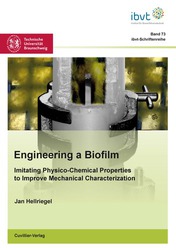| Fachbereiche | |
|---|---|
| Buchreihen (96) |
1378
|
| Nachhaltigkeit |
3
|
| Gesundheitswesen |
1
|
| Geisteswissenschaften |
2364
|
| Naturwissenschaften |
5406
|
| Mathematik | 229 |
| Informatik | 319 |
| Physik | 980 |
| Chemie | 1363 |
| Geowissenschaften | 131 |
| Humanmedizin | 243 |
| Zahn-, Mund- und Kieferheilkunde | 10 |
| Veterinärmedizin | 108 |
| Pharmazie | 147 |
| Biologie | 835 |
| Biochemie, Molekularbiologie, Gentechnologie | 121 |
| Biophysik | 25 |
| Ernährungs- und Haushaltswissenschaften | 45 |
| Land- und Agrarwissenschaften | 1004 |
| Forstwissenschaften | 201 |
| Gartenbauwissenschaft | 20 |
| Umweltforschung, Ökologie und Landespflege | 148 |
| Ingenieurwissenschaften |
1793
|
| Allgemein |
98
|
|
Leitlinien Unfallchirurgie
5. Auflage bestellen |
|
Erweiterte Suche
Engineering a Biofilm (Band 73)
Imitating Physico-Chemical Properties to Improve Mechanical Characterization
Jan Hellriegel (Autor)Vorschau
Inhaltsverzeichnis, PDF (50 KB)
Leseprobe, PDF (120 KB)
Biofilms play a major role in material cycles and contribute to technical systems significantly. Despite their interference with the functionality of technical equipment or the product quality their ability to catabolize toxins and metabolize pharmaceutically relevant substances increases the interest in biofilm-based biotransformations. However, so far there is a lack of appropriate models that allow anticipating the mechanical stability of biofilms in particular during detachment processes.
The main objective of this work was the development of a hydrogel based physico-chemical and growth independent biofilm imitate to investigate mechanical, primarily fluid dynamical stresses and their influence on growth and detachment effects of biofilms. Verification was achieved by comparison with real single culture biofilms. Single culture biofilms of Pseudomonas putida KT2440 were cultivated in a biofilm tube reactor and grown on different surfaces, e.g., tube walls, surface-modified object slides, plastic and iron nettings as well as membrane filters. The establishment of on-line analytics allowed the automatic measurement of dissolved oxygen, pH, temperature and planktonic cell growth by optical density in the cultivation broth. Image acquisition of the biofilm surface supported the observation of biofilm development in terms of growth and detachment.
A hydrogel based on gellan was established as simplified artificial biofilm system, which behaves like a viscoelastic fluid. The degree of cross-linking at different gellan levels was modified by the addition of mono-and divalent ions (Na+, Mg2+) and the influence on the material constants in terms of storage (G’) and loss (G’’) modulus was determined. Experiments and evaluation in the predefined design space were supported by Central Composite Design (CCD), an experimental design technique.
The developed gellan-based hydrogel allows mimicking the mechanical properties of a biofilm excluding biological growth effects. It can now be used to validate further characterization methods or to test slowly growing biofilms where systematic errors are often smaller than the biological variances. Eventually this method enables a fast and reliable mechanical testing of biofilm systems.
| ISBN-13 (Printausgabe) | 9783954047536 |
| ISBN-13 (E-Book) | 9783736947535 |
| Buchendformat | A5 |
| Sprache | Englisch |
| Seitenanzahl | 146 |
| Auflage | 1. Aufl. |
| Buchreihe | Schriftenreihe des Institutes für Bioverfahrenstechnik der Technischen Universität Braunschweig |
| Band | 73 |
| Erscheinungsort | Göttingen |
| Promotionsort | TU Braunschweig |
| Erscheinungsdatum | 08.07.2014 |
| Allgemeine Einordnung | Dissertation |
| Fachbereiche |
Chemie
Biologie Maschinenbau und Verfahrenstechnik |
| Schlagwörter | Biofilm Mechanics, Gellan Based Hydrogel, Viscoelasticity, Design of Experiments (DoE), Surface Response Methodology, Fouling |








